Review of the game cloud services market
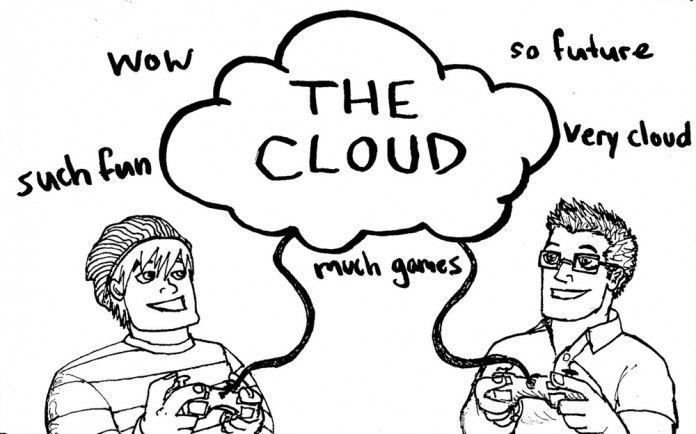
Figure Hector Lizarraga
In this article, I tried to write an overview of the market for cloud services games, including the history of its development and current status. The starting point for this article was an English-language article on Wikipedia for the lack of its Russian-language version, which was supplemented with information on this topic from various sources, as well as personal experience using some of the services. Since I am far from professional in this field and am only interested in the user, this article does not claim accuracy, authenticity or objectivity.
Definition and types of services
Cloud games (Cloud gaming) is a type of online games that involves providing ubiquitous and convenient online access to games that are located on the company's server, and not on a computer or gamer device.
Games in the cloud are usually divided into 2 types. The first type includes systems with streaming part of the game as needed (File Streaming), the second type includes systems with video streaming (Video Streaming).
File Streaming
In such a system, when buying a game, only a small part of the code, approximately five percent, is loaded onto your computer initially. This allows you to start playing instantly, while the rest of the code is downloaded and installed as the game progresses. Examples of such a service may be, for example, the already-dead Kalydo project and the current Utomik project. At the moment it is already exotic. Not a single sane service, working on this principle, I have not met.
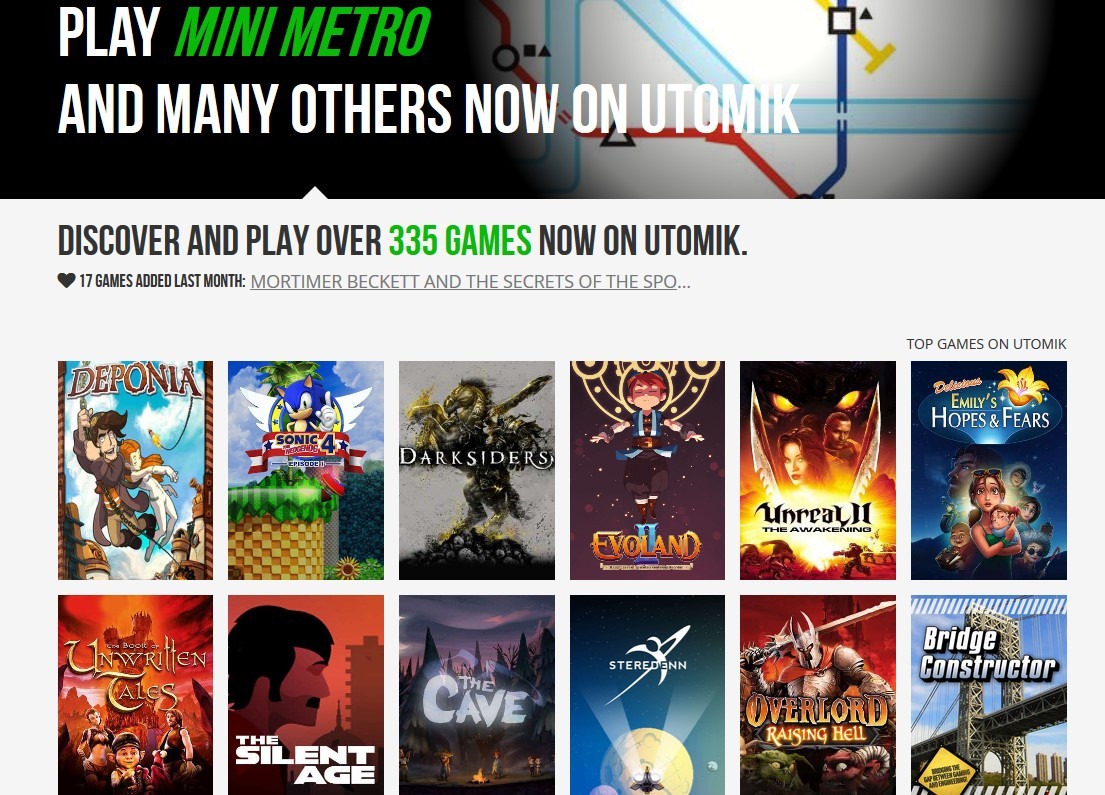
Screenshot from Utomik website
Video Streaming
Streaming video, when it refers to cloud games, includes hosting and processing almost all game content on the service provider's servers. All computational operations are handled by the remote server, which means that these games can be played on virtually any device. Examples of such a service might be, for example, OnLive, LiquidSky and Playkey projects.

Description of Playkey operation from the Nvidia website
In addition, in Video Streaming, there are 2 existing subtypes of the services offered. In the first case, the client can only play those games that are available from the service provider. For example, the Playkey service has a list of games that a gamer can play. In order to play any of them you need to either buy the key from the Playkey service or you can play with the previously purchased key from the Steam service.
In the second subtype, the user buys only resources on a remote server. This principle works Liquidsky service, where the user himself acquires any content from Steam or another content provider and runs it in the cloud.
A little apart from the systems listed above, there are services for transferring data from one user device to another. An example of such a service is, for example, the Remote Play service. In this case, the game is processed not on the remote server, but on your home console, and transferred to your PC.
The history of development
The whole history of the development of games in the cloud since the inception of ideas for 2012 can be viewed on the infographic here on the website of Big Fish Games, developer of casual computer games (in 2013, the division dealing with games in the cloud was closed due to insufficient profitability). According to them, the idea of clouds originated in the 50s of the last century. For all the information on their website, you can see a list of sources.
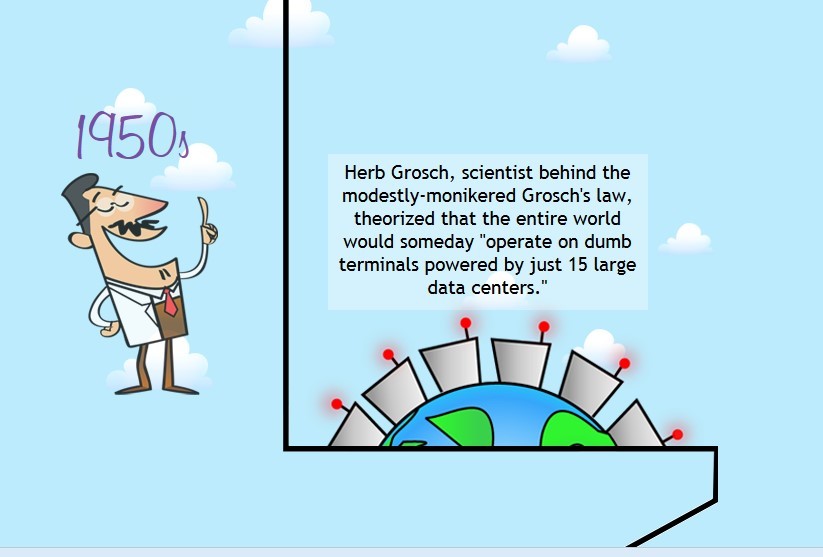
Part of the infographic from the Big Fish Games
website On the Wikipedia site related to cloud computing, you can find the opinion that the first concepts of using computing resources on the basis of the utilities system date back to the 1960s. Which of them is right, in principle, is not important, because at the moment this story has a distant relation to the current day. Ideas arose, technologies developed, and in 2009, two of the most famous competitors at that time emerged: Gaikai and OnLive services. They presented a mass product that could work on any computer and worked with low latency, similar to a local gaming device.
The history of these services has evolved differently. Owners of Gaikai service sold their service to Sony in 2012 and got a good sum in the amount of $ 380 million for their offspring. On the basis of this service, Sony’s own project, PlayStation Now, was launched later.
The OnLive service was not so successful. First, the project went bankrupt in 2012, then resurrected under the same name, but with other owners, and finally ceased to exist in 2015.
This is not to say that these projects were the only ones at that time. But none of these projects has achieved such a position in the market as these 2 services.
Collapse OnLive
OnLive was announced at the international exhibition Game Developers Conference 2009, which was held in San Francisco from March 23 to March 27, 2009. The service offered gamers the opportunity to play even on a very weak hardware - if only there was a fairly fast and stable network connection. All information was processed on the service side, and the user received the gameplay and the ability to control this process.
Naturally, such opportunities could not pass unnoticed by gamers. According to OnLive data for 2012, the service had 1.5 million active users. The gaming library contained 250 different games, from purely console and computer games to mobile games.
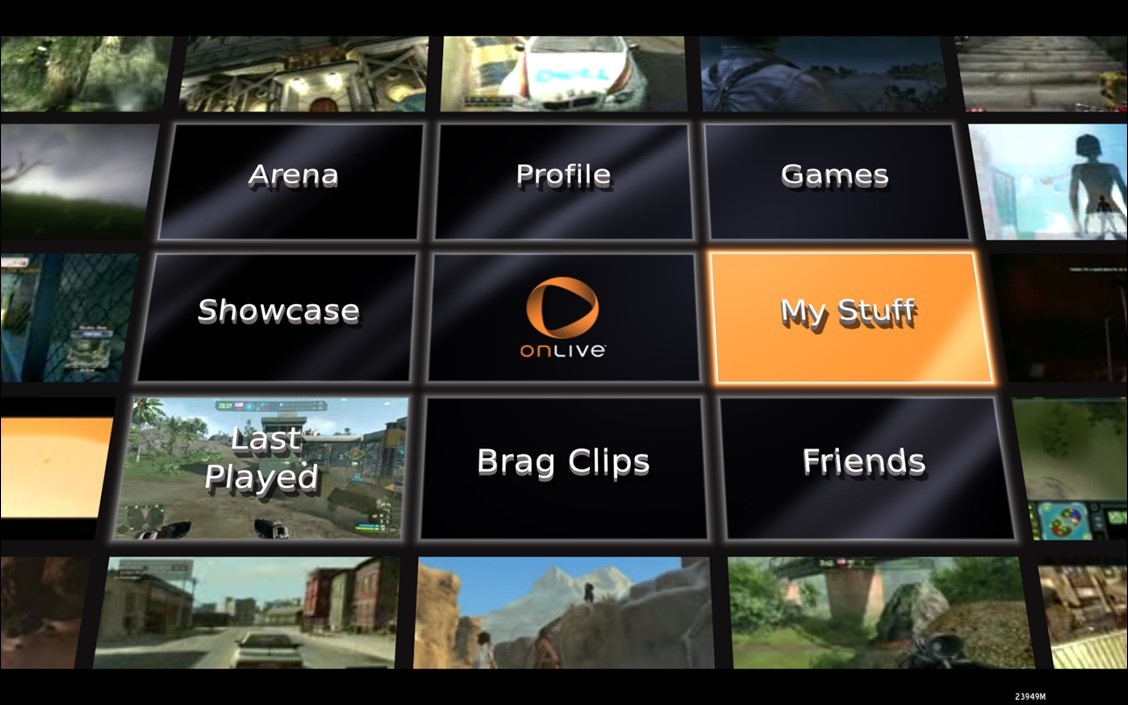
Screen shot from the site OnLive before the closure of the service
However, in 2012, the company actually went bankrupt. She had to lay off all employees and sell all assets for $ 4.8 million. As a result of this bankruptcy, the company's investors suffered significant losses. One of the victims, for example, was the company HTC, which had to write off $ 40 million losses.
It is believed that OnLive’s problems were caused by poor management decisions, low profitability and a small library of games. The founder of the company was Steve Perlman, a talented developer and entrepreneur, but a worthless manager. The company used thousands of servers around the world, burning $ 5 million monthly, but the number of users never exceeded 1,600 players at a time. In addition, only a small percentage of these users actually paid the company for the service provided. More on the history of bankruptcy OnLive can be found here .
With all this technology OnLive were advanced. The developers created a system that worked stably, without problems on the user side with good communication.
After bankruptcy, all OnLive patents and assets were sold to the investment company Lauder Partners, and then the OnLive service was restarted, but with a new team.
The last effort to gain a foothold in the market was the service CloudLift, which offered modern games from Steam and the instantaneous continuation of an interrupted game session on another device. Just before closing, OnLive even started offering the CloudLift Enterprise option: streaming business applications to low-power devices for large corporations and enterprises.
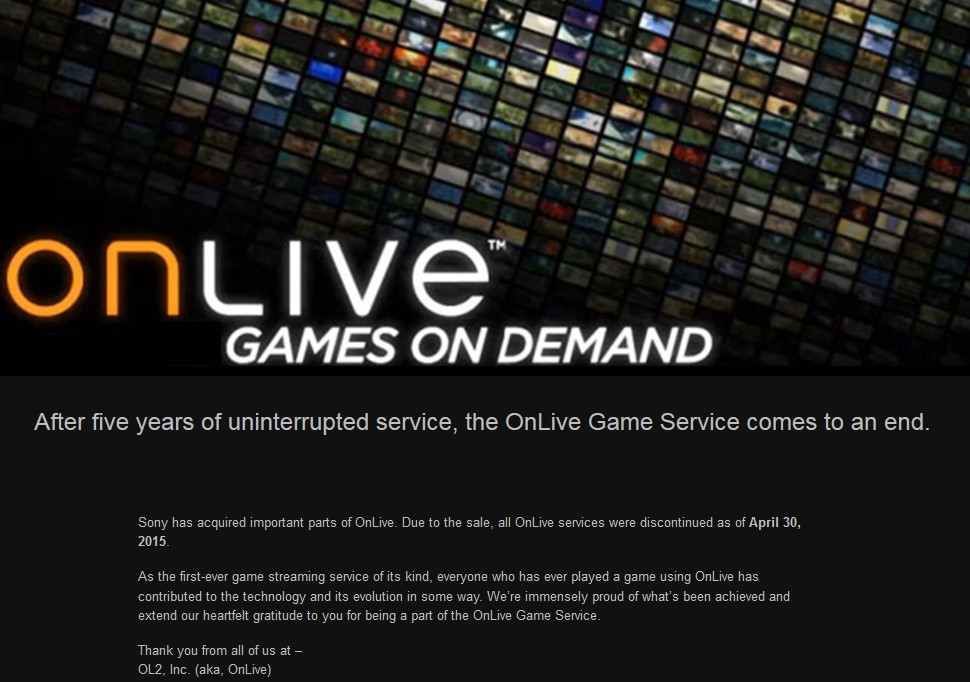
Screen shot of the site OnLive with information about the termination of the service
However, all this did not help and in 2015 the company announced the sale of all patents to Sony and the termination of activities.
Gaikai success
Gaikai was also announced at Game Developers Conference 2009. The company was going to do it later, but the OnLive announcement at GDC 2009 forced the company to take a second step.
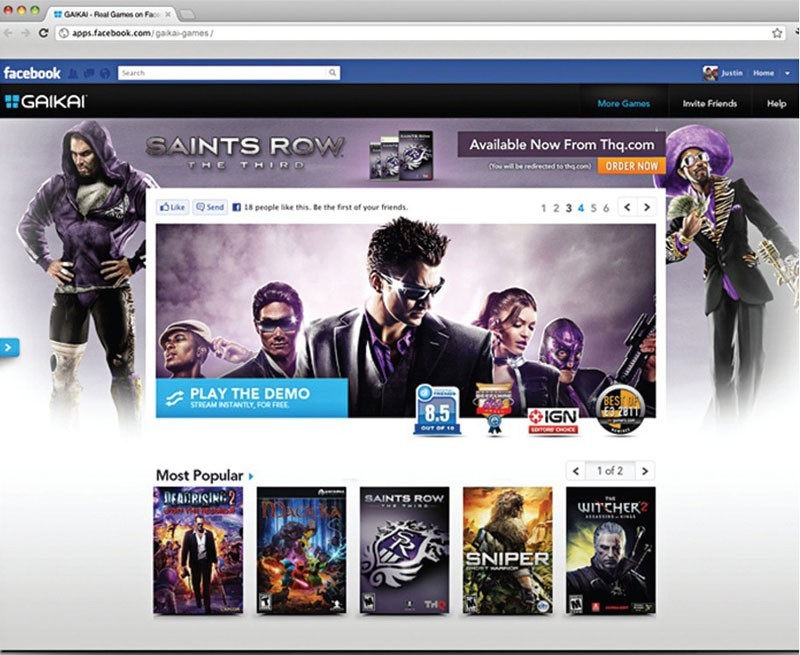
Screenshot from the Gaikai website
On July 1, 2009, Gaikai founder David Perry published Gaikai data on his personal blog, as well as a demo video. Some games were shown on the video, including Mario Kart 64 and World of Warcraft running in a browser window. Perry stated: “We developed this [meaning Gaikai] for the real Internet. We do not declare that we have 5,000 pages with patents, it did not take us seven years, and we do not declare that we developed a specialized hardware chip for encoding with a one-millisecond delay. As you can see, we do not need all this, and therefore our expenses will be much less. ”
On the same day, GameSpot published an interview.with David Perry, in which the latter talked about the Gaikai service, about its difference with OnLive, about relationships with publishers and about the business model. Unlike OnLive, the company did not try to sell cloud services to the end user. Instead, it provided a platform for computer games makers, where players could try out demo versions of the latest innovations for free.
As Perry told OnLive in an interview, “They plan to fight Sony, Microsoft and Nintendo at the same time, which will be a daunting task.” In addition, they will have to use an expensive marketing strategy to attract players. And even if they can do it, they can take away only a certain share of the market from Nintendo, Sony or Microsoft. ”
As history has shown, this approach worked, and in 2012 it was announced the sale of service for $ 380 million to Sony. At the same time, in 2012, the companies OnLive and Gaikai had similar technologies. For example, here you can see a detailed comparison of the work of these 2 services on the example of several games.
Cloud gaming services today
On the Wikipedia page there are a couple of dozen services, active and already deceased. Let us try to understand this apparent abundance. I dropped the inactive projects as well as projects related to streaming files. As a result, the list of projects for review has been significantly reduced. The rest were divided into 3 parts: existing commercial projects for PC, projects for set-top boxes and TV, and small projects.
Commercial PC Projects
▍LiquidSky
The founder of the service is a young 23-year-old Ian McLoughlin. The service itself is in beta testing, which does not prevent it from having more than 500,000 users worldwide today. In September 2016, the service received an investment of $ 4,000,000 from a group of investors. Read more about this here . LiquidSky service is built on Nvidia GRID technology.

Screenshot of the VirtualSky Virtual Desktop Service
This service is interesting primarily because the Liquidsky service itself doesn’t matter what you are doing in this cloud. A typical situation is when players, using this service and having an account on Steam, quickly download any previously acquired game to a remote server, launch it and play at their own pleasure, while remaining in Steam itself. In this case, paying a monthly subscription for $ 14.99, users receive in addition 500 GB for storing data on the server. If you look at Dropbox, which asks for $ 8.25 for 1 TB of data, it does not seem that expensive. The subscription limit is 80 hours per month.
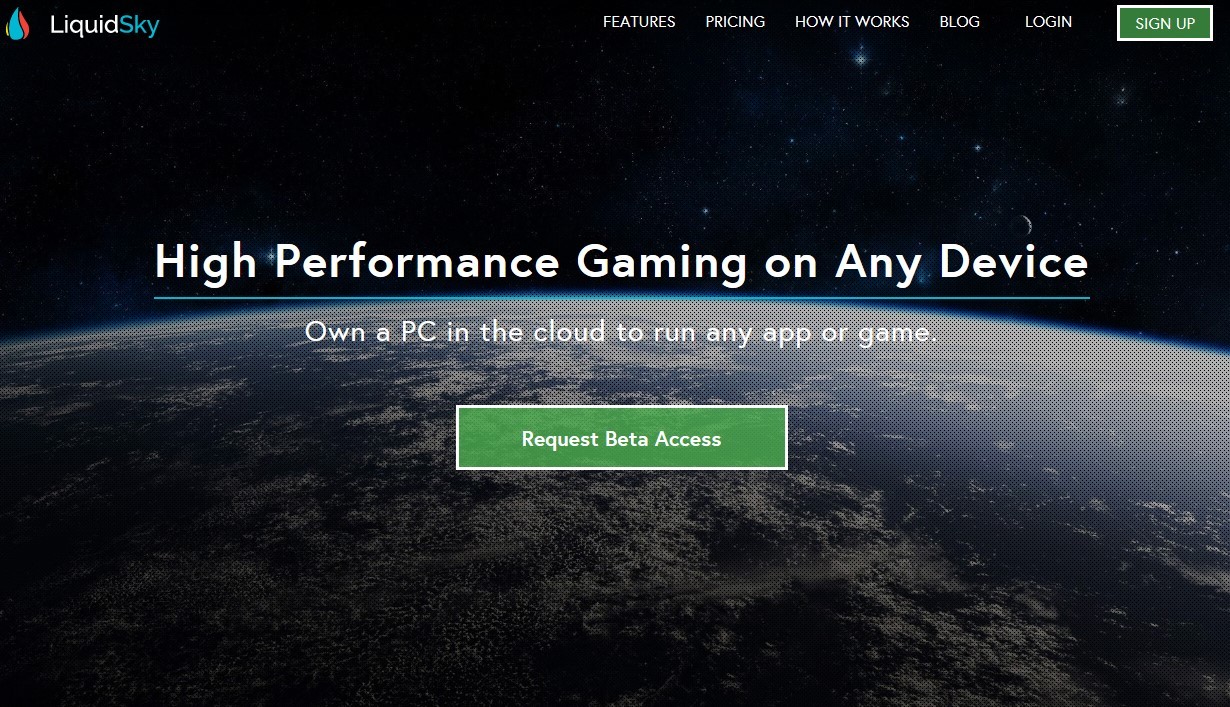
Screenshot from the site LiquidSky
This service appeared quite recently and at the time of its appearance had a huge number of bugs. Since the service is quite active in social networks and the Internet, you can see what kind of flaws the service has at the moment. A few months ago, for example, when I logged into my account, I noticed that the cursor was randomly moving across the screen, and I could hardly control its movement. When I finally went to my library of games on Steam, I noticed that there were other games there. It turns out that I got into someone else's account and we with the owner of this account struggled to control the cursor, which explained his strange behavior.
▍Playkey
The service itself is a Russian project, also built on the basis of Nvidia Grid. The implementation of the project creation idea began in 2012, and throughout 2014 the service was in open beta testing mode. At the turn of 2014-2015. The project has reached the release stage by launching into commerce.
On their website there is a list of games that the user can play. When paying a monthly subscription for 590 rubles. the user gets access to 150 free games on the service and gets the opportunity to buy some paid games and play them on Playkey. Subscription limit is 70 hours per month.
The project is local, which automatically protects it from other competitors. However, the original service did not go. You can read more about this in the article here .
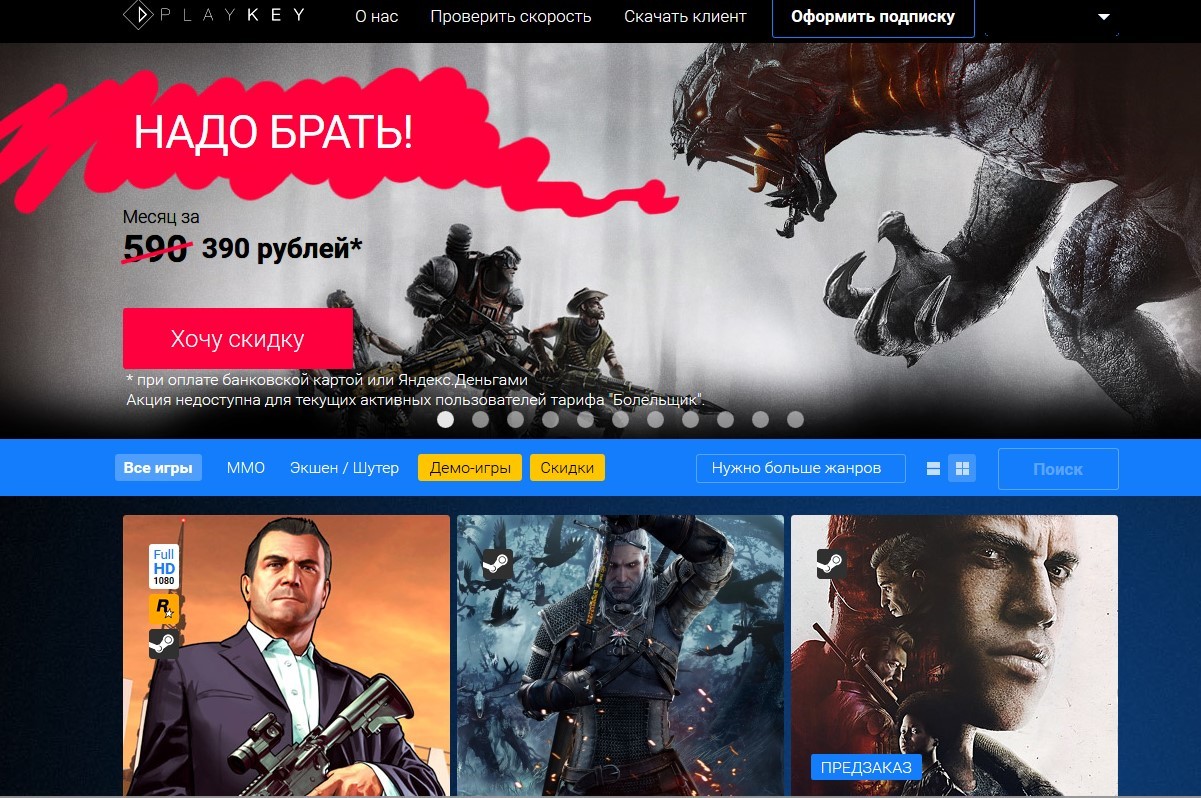
Screenshot from Playkey website
According to Playkey CEO Yegor Guryev, in May 2015, the number of paying users was only 282 people. However, the company managed to rectify the situation by changing the business model. As of March 2016, the service had 200,000 registered, 10,000 subscribed and 4,000 regularly paying users. To change the situation, the following changes were made to the company's activities:
- Changed the business model - “At the first stage, we had a subscription, buying which, the user got access to 120+ games, but in this way we could not get new items from developers and offered old content, .... Values in this collection, users have seen the minimum. The games that are available for low cost on the sales, many have not passed once and at the same time worked well on computers that have been upgraded 1-2 years ago. The developers did not allow new content to be subscribed, and it’s understandable why - they were afraid of losing revenues from selling games at retail, while receiving absolutely unpredictable subscription revenues. We launched a piece of content purchase and the ability to play games that were purchased earlier. This gave us access to new products that occupy 85% of the demand. In this case, a subscription to the catalog of games (which was abandoned), we transformed into payment for the use of our server capacity. By current indicators, we see that on average, the user plays Playkey for 20 hours per month. ”
- Rebuilt marketing - “We are faced with a very low conversion, due to the fact that our communications did not have an answer to the question - who are we, what are we, what problems do we solve. Now we are focused on one thing - “Play modern games on a weak computer.” The clip “GTA 5 on the calculator”, which we sponsored, has 820 thousand views on YouTube ”.
- We changed the content - “We talked about this in paragraph 1, but I would add that we focused our offer on those games that are demanding of the user's computer and are in high demand (that is, new items). From the rest we refused. Therefore, we do not have JA2, 3 Heroes, etc. These games work well on weak laptops and can be played without using our technology, saving money. ”
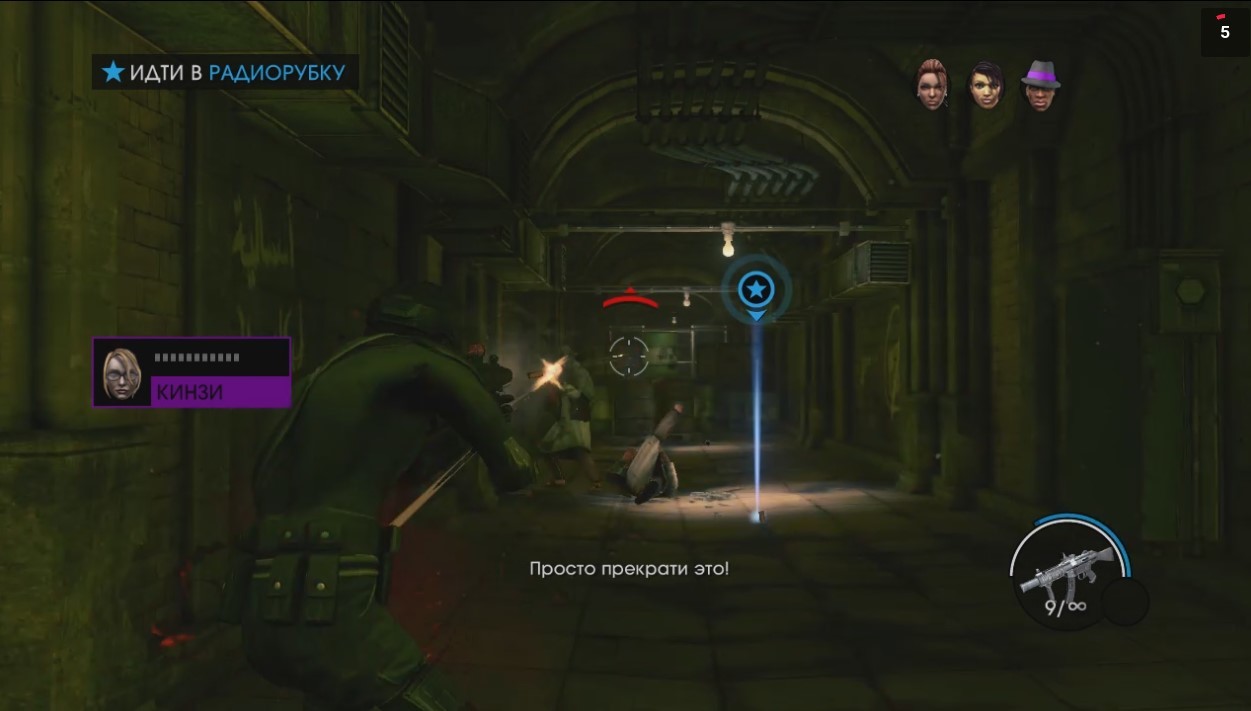
Screen shot of Saints Row 4 game launched on Playkey
If you compare the problems of Playkey in 2015 with the causes of OnLive bankruptcy in 2012, you can see the similarity of the sources of the problems for both companies: they both did not have a thoughtful business model, did not offer customers the content that would be in demand and both lacked a thought-out marketing strategy.
▍PlayStation Now
PlayStation Now is a game streaming service that allows you to play games for PlayStation 3 on PCs, mobile devices, TVs, PlayStation Vita, PlayStation 3, PlayStation 4. The service itself is the result of using technology and development from Gaikai, which Sony acquired in 2012 for $ 380 million. Officially launched as a subscription service in the United States on January 13, 2015.
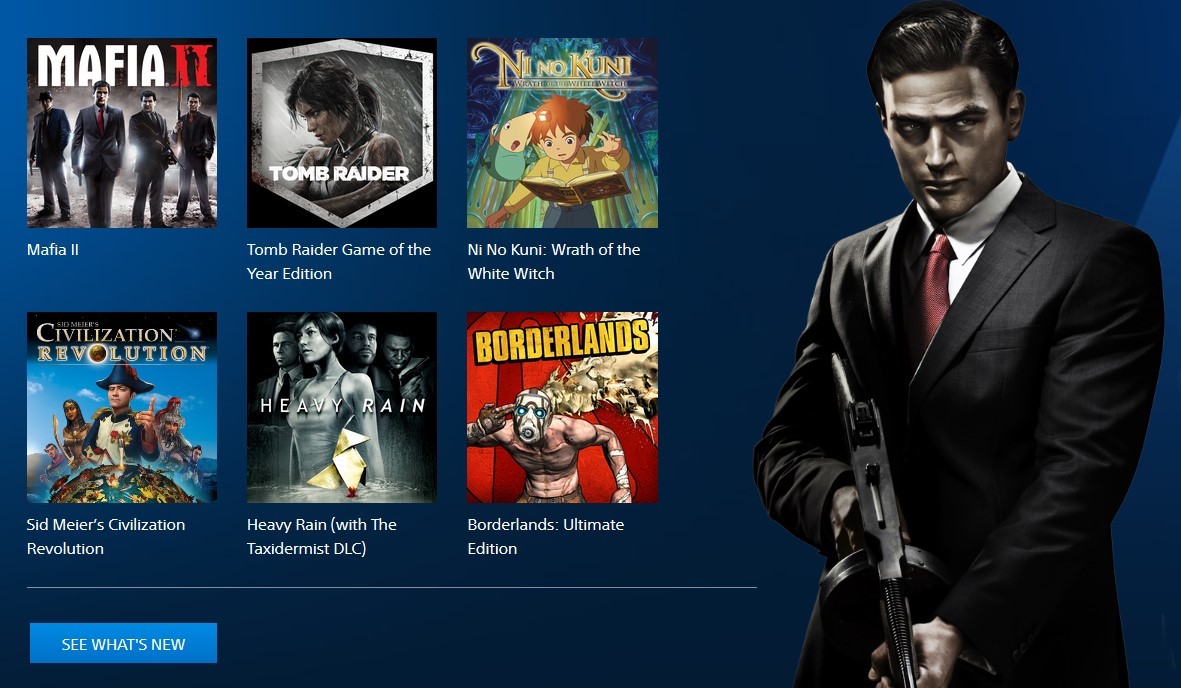
Screenshot from PlayStation Now
In August 2016, the first PlayStation Now for PC was launched in the UK, Belgium and the Netherlands. At the moment, the service provides access to more than 400 games released on the PS3. For new users, a seven-day free trial is available.
All you need to use is to download a special PlayStation Now application and connect DualShock 4 or another joystick. The service is not yet available in Russia, but some craftsmen have found ways to circumvent this restriction. Here you can see how they did it.
According to the latest data, the company has sold over 40 million PS4 consoles worldwide — a huge market for the company. However, the service has a problem, which is, in this service you can play only games for PS3. The reason for this lies in the technology used by Sony.
Because of the same features on PS4 consoles, it is impossible to play PS3 games without a cloud service, since These consoles are not fully compatible.
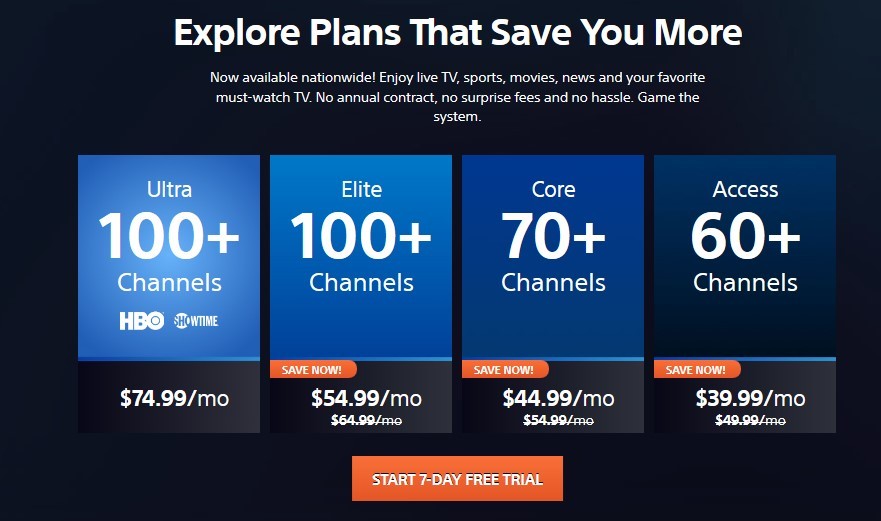
Discounts on PlayStation Vue
In addition, Sony’s service is quite expensive - the PlayStation Now is the most expensive of the listed services and costs $ 20 for 1 month of subscription. And the pricing of their PlayStation Vue service for streaming video to put it mildly, “surprised” me. For comparison, the Netflix service offers similar services in the US for $ 9.99 per month.
Services for consoles and TV
I have never used such services, perhaps, therefore I am a little biased towards them. However, the GeForce NOW and GameFly projects are large developing projects that I could not miss. They had to select a separate category. The picture below I took from the site Nvidia. It is unlikely that it can be called objective, but from it you can make a general idea about the services of GeForce NOW, PlayStation Now and GameFly.
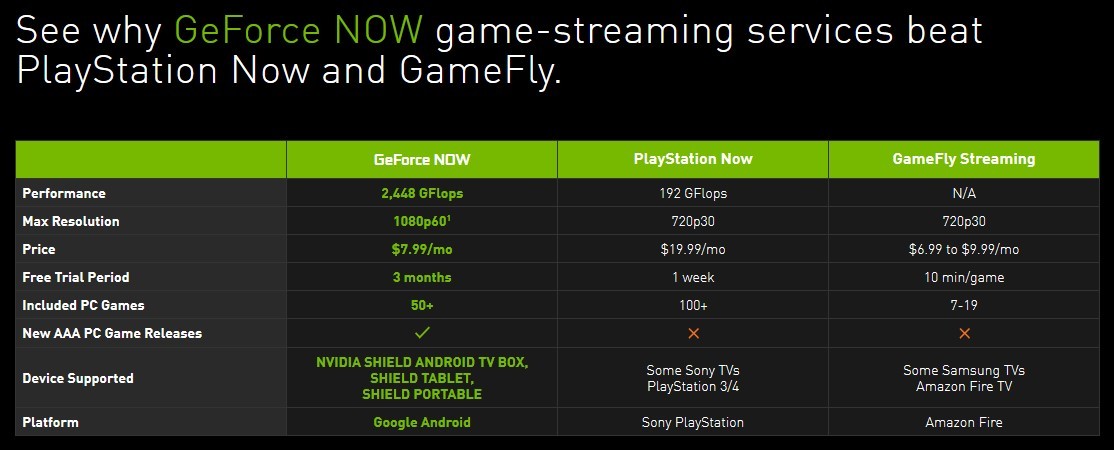
Comparison of services from the site Nividia
▍GameFly
Previously, the company's business was expressed in the figure below. As you can see from it, the company used to provide rental games. But time passed, and already such a model ceased to be competitive in the modern world.

The old GameFly business model
Therefore, in June 2015, it acquires the Israeli company Playcast Media Systems, and immediately launches a new service. The company changes its priorities and begins to look up to date.

Screenshot from GameFly website
At this point, North America and Europe are the main markets for the service. According to the company, the number of subscribers to the service is about 334,000. To use it, you must be the owner of one of the smart TVs manufactured by LG, Samsung or Philips.
▍GeForce NOW
The GeForce NOW service allows you to play on Shield Portable, Shield Tablet, Shield Android TV by subscription. The service offers 3 months for free to customers of Shield series devices, and then a subscription payment for $ 7.99 per month is required. Most of the games are included in the subscription, but you have to pay for the rest.
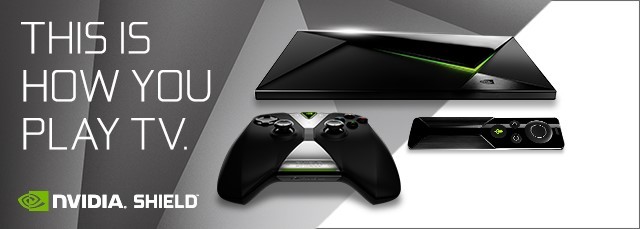
Devices for using GeForce NOW
I could not find the number of subscribers to this service, but, according to the company, more than 100,000 people in 190 countries of the world participated in testing the service.
Small projects
▍Ubitus GameNow
Service is more dead than alive. The latest articles and tweets on this service of the Taiwanese company Ubitus refer to 2013. The service has a working site with games, but only a couple of them I was able to run after several attempts. I can not say that I have a great Internet, but my other services were launched without any problems.
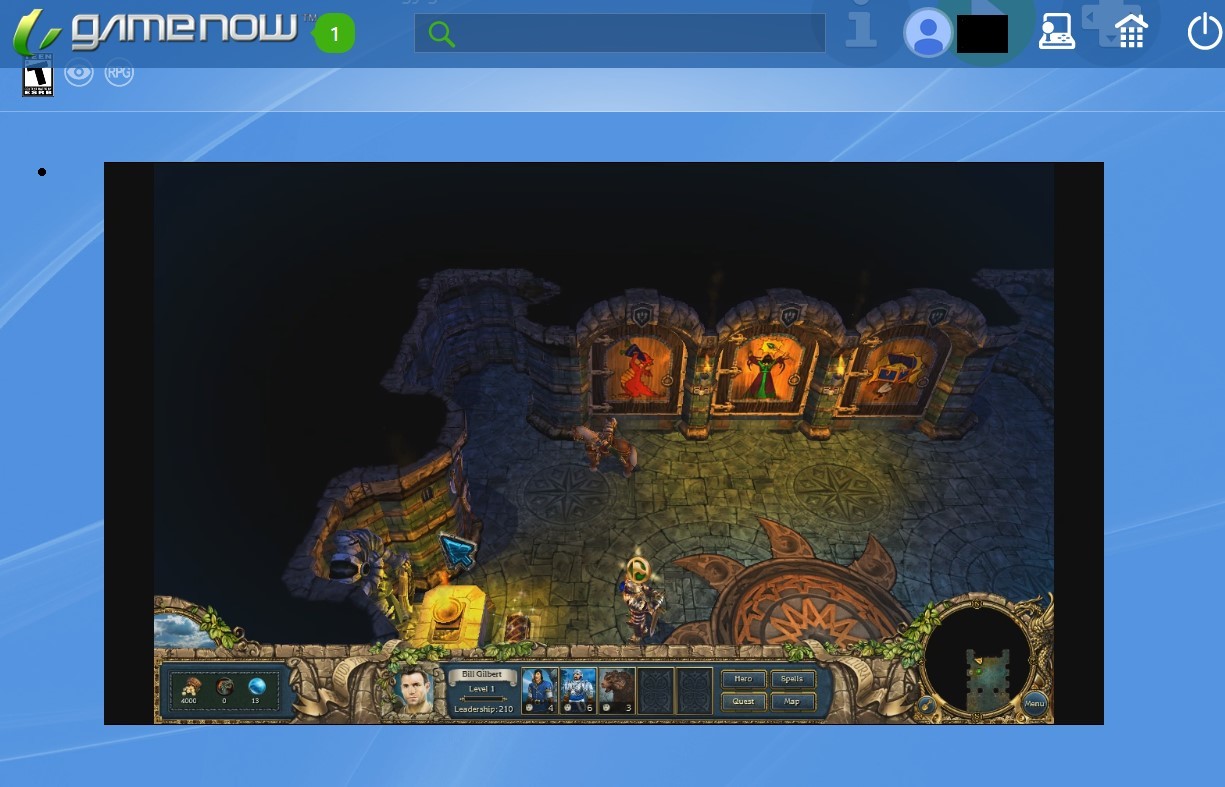
Screenshot from Ubitus GameNow with King's Bounty: The Legend
▍PlayGiga
Despite the start of the project in 2013, the final product was not presented to users. The company maintains a website on which information is updated, but the project has not yet taken off. It is not even clear on which platforms they are going to work.
▍face
From the series all ran, and I ran. It seems that the company Crytek, the creator of the service, did not fully understand what games are in the cloud, and made a forum for the players to communicate their game.
▍Kalydo
On the Wikipedia page it is indicated that the service is operational, however, it seems that he quietly died in early 2016, or maybe earlier. It was a file streaming service where you could start playing almost instantly after purchasing a game, and the rest of the data was downloaded as the game progressed.
▍LoudPlay
The Russian project, which has not yet taken off. There is practically no information on the project site itself. There are several reviews on testing the service. The essence of the service is that the user rents a game server on which you can install any game. According to some information on the Internet, the service is dead, and its developers have evaporated.
▍Playincloud
Also, the Russian project is very peculiar. According to the developer’s assurances, the service is not commercial, but there are tariffs for its use on the site. Players use the service in turn: one came in, the other came out. The server is preinstalled with games that users can play.
▍Leap Computing
Has not taken off and already, maybe, and will not take off. The developers demonstrated the operation of the system under controlled conditions, and the project stalled there. The developers promised a year ago to provide a working version, but it's still there.
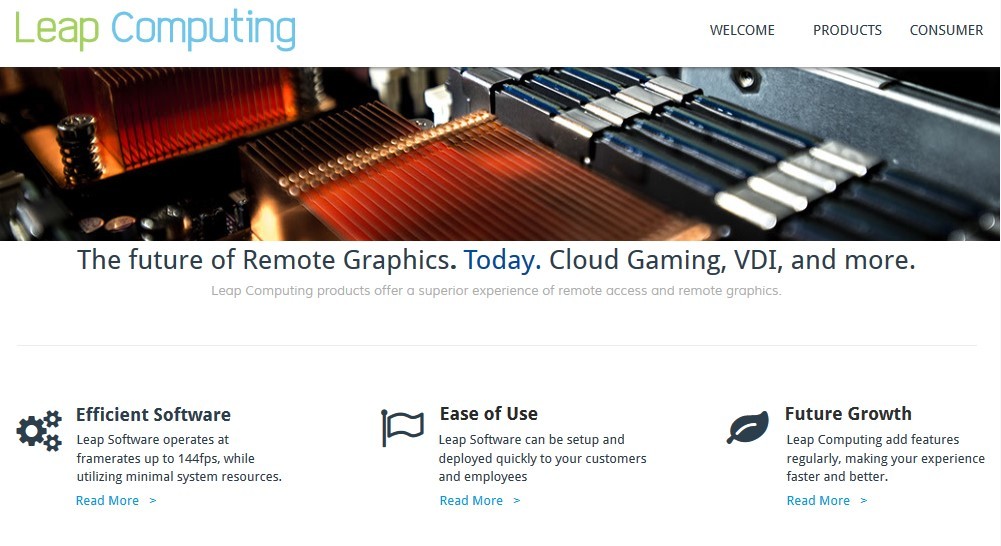
Screenshot from Leap Computing
▍Turbo.net
Service does not apply to games. As indicated by the developers of the service, it is designed for developers and IT managers and allows you to create a virtual space for developed applications.
▍G-cluster
Initially, I believed the information on the Wikipedia page that the service stopped working, but this was not entirely true. Yes, G-cluster Global Corporation itself went bankrupt and was liquidated, but all of its assets, patents, etc. moved to its parent company Broadmedia Corporation, which continued to provide services for the provision of service. But the error on the page is clear, because I could not find a single assessment in English, how really this service works well.
The service is a pioneer of streaming games and was created back in 2000, but it never became profitable, which caused the liquidation of the company. During all this time, did not become popular in the world. It seems that it is not very popular in Japan, the main market for this service, based on estimates on Google Play.Here you can see the history and business model of this service for 2010.
▍ Others
There are other participants in the cloud games market, about which there is nothing in this article. For example, it marked Ubisoft Entertainment, Amazon, CiiNOW, GamingCloud, Google, Happy Cloud, IBM, Microsoft, Nintendo, Samsung Electronics, TransGaming, Valve (took this list from the analytical report of the company Technavio). As you can see in this list you can find almost all large companies in the field of electronics. Probably, other companies offering network solutions like IaaS, PaaS or SaaS could offer some product to end users, but so far no such attempts have been made.
Comparison of the use of services Playkey and LiquidSky
For the Russians from the major services of games in the cloud, so far only these 2 specified projects are available. There are, for example, the Russian Playincloud or Ubitus GameNow, which you can also try to use, but they are either small or only partially functioning.
For a visual comparison of these services I used the game Europa Universalis 4, a computer game in the genre of a global strategy, which was developed by Paradox Interactive. This is not the best game to compare these two systems, but its example is sufficient to illustrate the difference in performance between the two services:
- The first thing that catches your eye when comparing the two pictures below is language. On the Playkey, all games are presented in the Russified version. I usually prefer games in English, as usually the quality of the translation causes sadness. In addition, I do not like windows with text, where either the words cling to each other, or strange voids are formed.
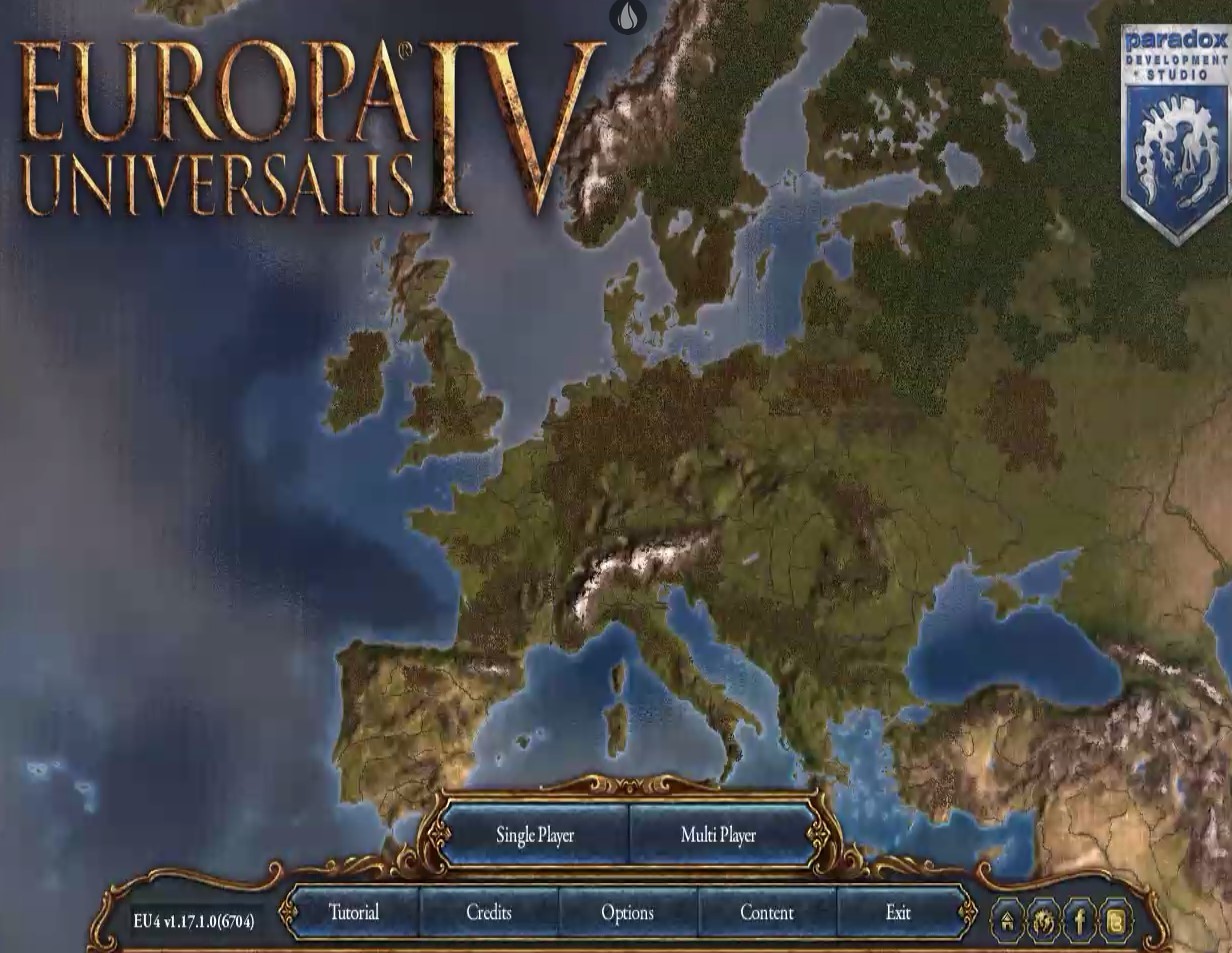
Screenshot of the Europa Universalis 4 game launched on the LiquidSky service - After that, the version of the game attracts attention. In the first case it is 1.17.1, and in the second - 1.1.0. Version 1.1.0 was released on August 13, 2013, and more than 40 patches were released between it and the current one. In addition, the EU4 developer has a pernicious passion to release various paid DLC, which of course are not available for version 1.1.0. It also follows from this that various mods will also not be available to you. This does not mean that for other games the same lag is far behind the current version, but the situation is still unpleasant.
- The next difference is that in Playkey, games are saved in the Playkey cloud, and not on Steam or on your home PC. Comments of one of the moderators on the network about this: “To continue playing on your PC, you need saves that cannot be downloaded from the Steam cloud due to the lack of complete data synchronization between Playkey and Steam. But in Playkey support, you can ask saves, download and play on your PC. If the game saves on your PC are synchronized with Steam, then you can play Playkey again. Everything will be simplified later when full synchronization becomes possible. ”

Screen shot of Europa Universalis 4 running on Playkey - The closest LiquidSky server is located in Germany, so with all these shortcomings, the Playkey service works fine, which I cannot say about LiquidSky yet. Periodically, there are some interferences on the screen and the cursor movement noticeably lags. LiquidSky developers state that for optimal operation the user should be at a distance of no more than 1,500 km from the nearest server. For residents of Moscow, this is Frankfurt at a distance of 2,022 km in a straight line, so it’s impossible to enjoy all the possibilities of service to the residents of Moscow. At best, my ping was 79 ms, and the average was somewhere around 102 ms. For Playkey, this figure was about 50 ms.
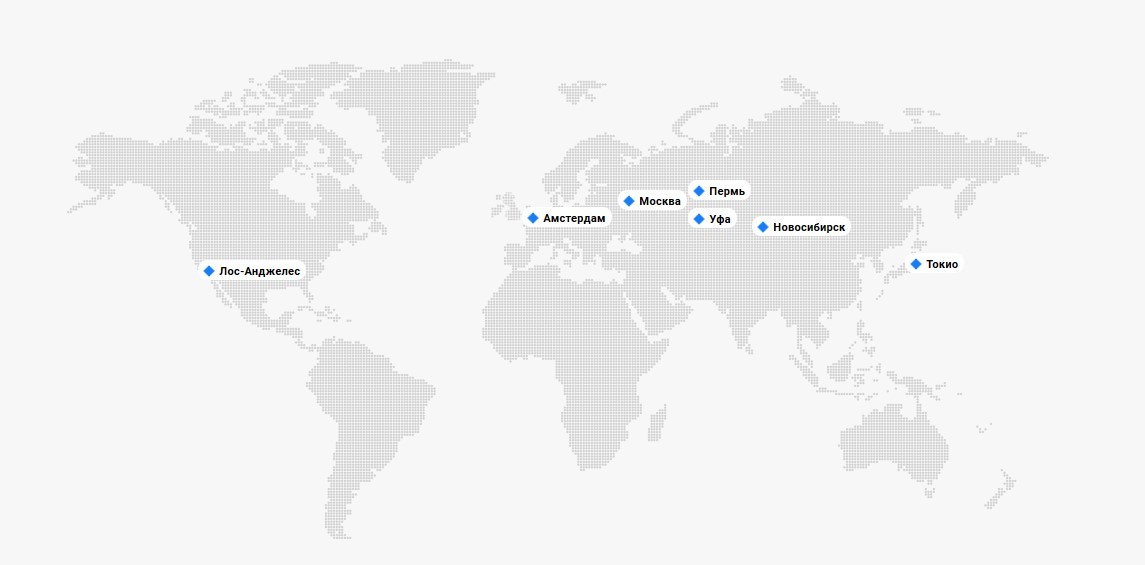
Location of Playkey servers - The LiquidSky service gives the player the opportunity to play any game in his Steam library after downloading and installing the game, but the Playekey service allows you to run any game on the server almost instantly, without wasting time downloading and installing it.
As can be seen from the comparison of the services provided, both have their own advantages and disadvantages. For me personally, the LiquidSky service is more interesting, but the remoteness of the available servers negates all the advantages and does not allow using this service.
Pros and cons of games in the cloud for end users
The advantages and disadvantages of gaming in the cloud have not changed since the OnLive and Gaikai. However, with the development of technology, quality of communication and acquaintance of an increasing number of users with this technology, the priorities of these features change, i.e. how important they are to the user.
Benefits
- Saving on a new computer - with the cloud, there is no need to update the computer. Instead of buying expensive gaming equipment, you would simply use an existing one.
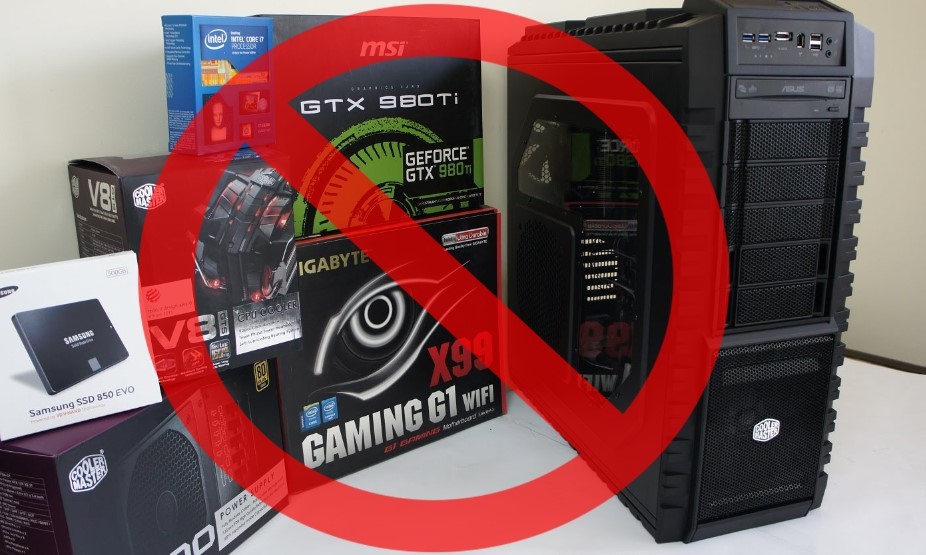
No need to buy expensive iron - Ability to play games on any OS or device - most of the top games are available only on a computer or console. The cloud will allow you to play these games on any device, despite its technical characteristics and OS: tablets, smartphones, computers, TVs and consoles running any OS.
- Integrating the cloud into televisions and other devices - TV manufacturers have begun to integrate support for cloud gaming services into their televisions. With a joystick, any of these TVs turns into a game console.
- Ability to run games almost instantly - some games may take up 10 GB, 20 GB or even more space on the hard disk. The cloud allows you to free up this place, start the games immediately after switching on and start playing immediately.
disadvantages
- Picture quality - the higher the picture quality, the more resources will be spent in the cloud and the higher will be the requirements for the bandwidth of the communication channel and its stability. Often there is a situation when cloud service providers compress the picture coming to the end users.
- Internet traffic - cloud services require the consumption of a large amount of traffic. At the same time, the Internet speed should be stable, at least 5 Mbit. Playing games in the cloud, the user can spend more than 3 GB of Internet per hour. With the improvement of the picture quality, the flow of traffic increases proportionally. If game streaming becomes more common, network congestion will increase dramatically.
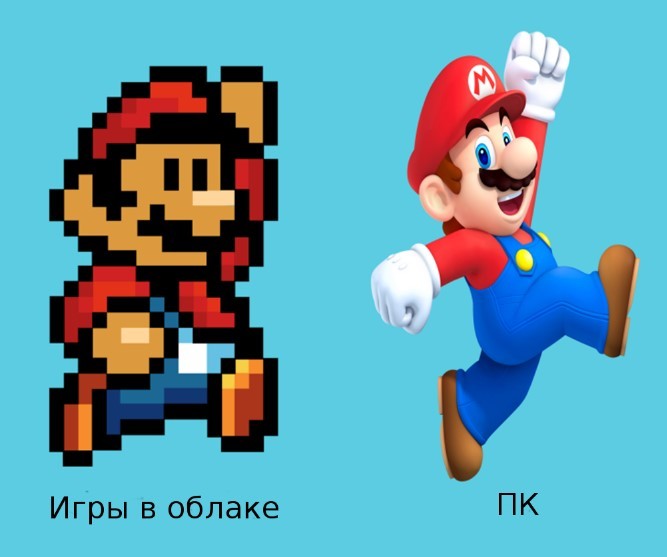
Picture quality in the cloud and on PC
- Delay - from which you can not get anywhere. The game will respond to player actions faster when it is running on the local computer.
- Copyright protection - Publishers may prohibit or restrict the use of games in certain territories, set their prices or terms of use.
- The emergence of a monopolist - a situation may arise when a monopolist emerges on the market that can establish rules in the local market.
- Bankruptcy service or changes in terms of use - the situation with OnLive may repeat, when all purchased games and subscriptions just disappeared in 2015, when Sony bought all of the company's assets, but did not compensate for any obligations to users.
As you can see from the comparison, if you need quality and reliability, then a traditional PC will suit you more. If you are an avid gamer and are going to play every day, then games in the cloud are not suitable for you. If you draw an analogy with the road, the game in the cloud - it's a taxi, and the home PC and the console - your own car. Continuing the analogy with cars, the use of cloud services in the presence of the latest version of the console is similar to the use of a taxi in the presence of its own car.
Technology
In 2009, when the OnLive and Gaikai services appeared, they showed that streaming games were possible. Prior to this, there was an opinion that this is impossible because of the high latency between the server and the local computer: the information must be on the network to reach the server, there to be processed, compressed and sent back to the client device.
Companies used different approaches to solve this problem. The OnLive service focused on the hardware and developed its own video encoder. Their idea, according to this article, was to divide the stream into 16 rectangular sections and process each of these sections with a separate coder. Gaikai approached the problem with the help of existing hardware solutions, but using his software groundwork.
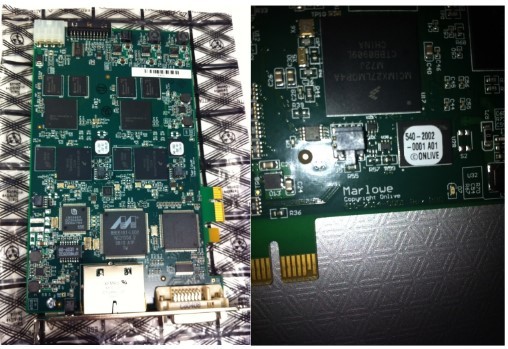
Own OnLive video coder
To date, there are 3 companies that own and use their own game streaming technologies: Nvidia, Sony and GameFly. Most other game streaming services use Nvidia technology.
Nvidia
Nvidia developed the Nvidia Grid technology, which was announced in 2012. The company immediately announced that Nvidia Grid is not a gaming service, but a product that will be offered to operators of cloud gaming services. At that time, this solution was used by almost all startups in this area, including Gaikai, Playcast, Ubitus, CiiNow and G-Cluster services. Now this technology is used by LiquidSky and Playkey. In this video Nvideo Grid shows the operation for the end user.

Job Description Nvidia GRID from the Nvidia website
The main element of Nvidia GRID is the Nvidia GPU. On the Nvidia website you can see the specifications and how it all works.
At the moment, the company offers its gaming service GeForce Now. To use it, you must have an Nvidia device: one of the devices in the Shield Portable, Shield Android TV or Shield Tablet product line.
Sony
In 2012, Sony acquired Gaikai. This allowed the company to create a PlayStation Now platform based on Gaikai technologies in 2014. In 2015, Sony 2015 acquired OnLive patents.
The new division of Sony has received the task to develop technology that would allow to run PS3 games in the cloud for PS4, TVs, tablets and smartphones. At first they experimented with installing ordinary PS3 in data centers, but the experiment was not successful for obvious reasons. After that, Sony developed a motherboard on which the reduced components of eight PS3 consoles are installed, which can operate independently. By placing such cards in data centers, Sony has created a PlayStation NOW service. The graphics processor used in this board was developed jointly by Sony and Nvidia 11 years ago based on the Nvidia GeForce 7 graphics processor.

Motherboard for the PlayStation NOW service
It is clear that due to this technology, the Playstation Now service can only work with games on the PlayStation 3.
Gamefly
In June 2015, GameFly acquired an Israeli company, Playcast Media Systems, which, it claims, offered its own “market ready and scalable” technology. This service is available on Amazon Fire TV and Samsung Smart TV devices. Compared to Nvidia and Sony, this company is much smaller, and previously Playcast used Nvidia Grid in its operations. I most likely would not have added this company to this list if Nvidia would not consider the GameFly service as one of its main competitors for its own service. This is evident from the comparison of their services from the Nvidia website in an article earlier.
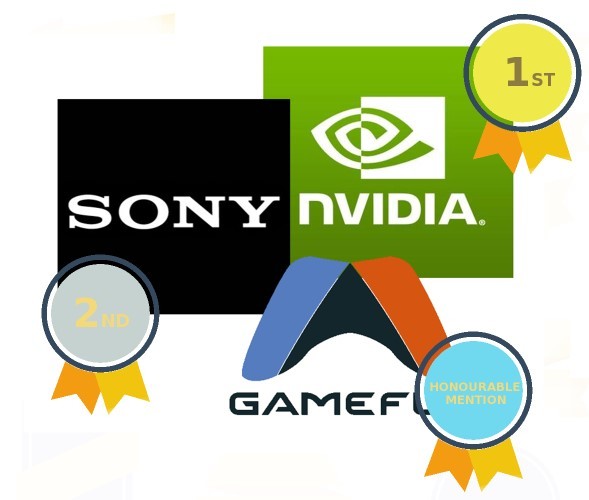
Existing companies in the market for streaming games with their own technology
Development and market problems
When the OnLive service appeared, it caused a stir. "The most powerful gaming system in the world" and "The Game Revolution" could have stumbled across the headlines of magazines and newspapers. In 2012, analysts shortly before his bankruptcy estimated its value at $ 1.8 billion. 4 years have passed since that moment, but it still remains difficult to predict the future of the game streaming market.
Situation in the world
In its report on the development prospects of the cloud gaming services market for 2016-2020, Technavio predicts that the global market will grow by 29% per year. It seems to be great prospects for market participants, even ahead of 18% growth in the streaming video market, according to Markets and Markets.
However, in retrospect, it is difficult to believe in the accuracy of this forecast. In a previous report, Technavio called G-Cluster, Nvidia and OnLive the main providers of gaming cloud services, of which 2 companies had already ceased their activities by this time.
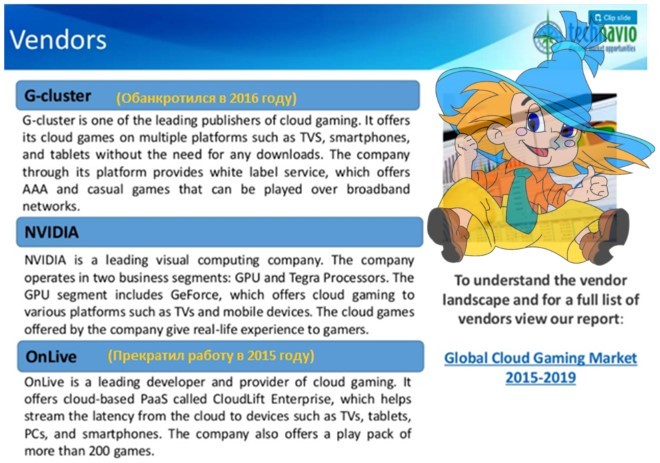
Picture from Technavio presentation (collage)
There is no doubt that the market for games in the cloud will continue to grow, because The speed and quality of the Internet in the world is constantly growing, and large companies have begun to invest in projects of the cloud gaming services market, but at the same time the market remains risky.
There are several factors hindering the development of the cloud games market. First, it is the delay in the transmission of the signal, from which it is impossible to completely get rid of. Unlike streaming video, where it is possible to use a memory buffer, this is not possible for games in the cloud.
The second problem is that large technology companies with well-established business of playing in the cloud are simply not needed. With the development of games in the cloud, cannibalization of the market for games on physical media and the drop in sales of computer equipment will occur. Perhaps that is why neither Nvidia nor Sony is seeking to massively introduce these technologies for the end user and offer them only as a kind of fashionable chip for their devices and only mostly outdated games.
In the future, companies working in this area may face problems that have arisen from the world leader in streaming video, Netflix. According to the latest information, during 2012-2016, the catalog of films offered by the service has decreased by 2 times. The reason is the complexity and cost of the rights to purchase content and increased competition in the market. The same thing can happen in the market of gaming equipment, because when using the cloud it becomes unimportant what device the player uses.

Netflix main competitors
Problems for market participants may arise not only with game manufacturers, but also their distributors, such as Steam, GOG.com, or Origin services. Thus, under the terms of the Steam Subscriber Agreement, all buyers are subscribers, i.e. do not own the rights to the purchased games and in the case of liquidation, Steam may lose all the games. Such an event may have a negative impact on market prospects.
The situation in Russia
Research company Akamai Technologies has published the results of testing the speed of Internet access in different countries. In Russia, the average speed of access to the Internet increased by 29% compared to last year and amounted to 12.2 Mbit / s for the first quarter of 2016.

Image from Russia Insider website
According to a statement from service representatives, the minimum bandwidth of the channel should be 5-15 Mbit / s for their use. However, this is only the minimum required speed, which I would have raised to at least 25 Mbit / s for comfortable use. For example, my provider gives me a 60 Mbps channel. Despite this, it often turns out that Playkey determines my poor quality of communication. Based on these estimates, if the same growth rate of the Internet speed is maintained in the near future, the required level of 25 Mbit / s in Russia will be reached in about 3 years.

A picture from a study by Yandex.
It seems that the diagram above shows that so far only in KFO and DFFO the speed of the proposed Internet is much lower than the required 25 Mbit / s, but all is not well. Just look at the reviews of one of the Internet providers offering speeds of 50 Mbit / s, like these: “Burn in hell”, “NOT FOR WHAT”, “Worse than where, deception”, etc. - and it becomes clear that these people are unlikely to become happy users of games in the cloud in the near future.
Conclusion
Over the past 7 years, since the emergence of OnLive and Gaikai services, the industry has come a long way. At the moment, the market is growing rapidly and while companies do not have to push their elbows to attract players. But soon this may change, the market will become saturated and large companies will start a battle for end users.
Despite the fact that many players have already managed to become disillusioned with games in the cloud due to the high cost of services, poor communication or outdated games, the talk about game streaming technologies is no longer surprising. The necessary technologies already exist, the speed of Internet communication is constantly growing, and companies offer players more and more advanced services.

Cloudy Mario
After leaving the market for OnLive and Gaikai services, you should not put an end to games in the cloud. Pioneers in business usually have a difficult fate. There is no need to go far for examples. The leaders of the modern market in most areas are not at all their discoverers. Not Amazon was the first to sell books over the Internet - first was Books.com. Searching the Internet is not an idea for Google, but companies like AltaVista. Social networks do not owe their appearance to Facebook - MySpace was before.
At the moment, a new stage in the development of cloud gaming services has arrived. Over the past few years, new services have entered the market. It has not finally become clear whether these services will be able to find their niche in the market, who will succeed in this market, and who will have to leave
